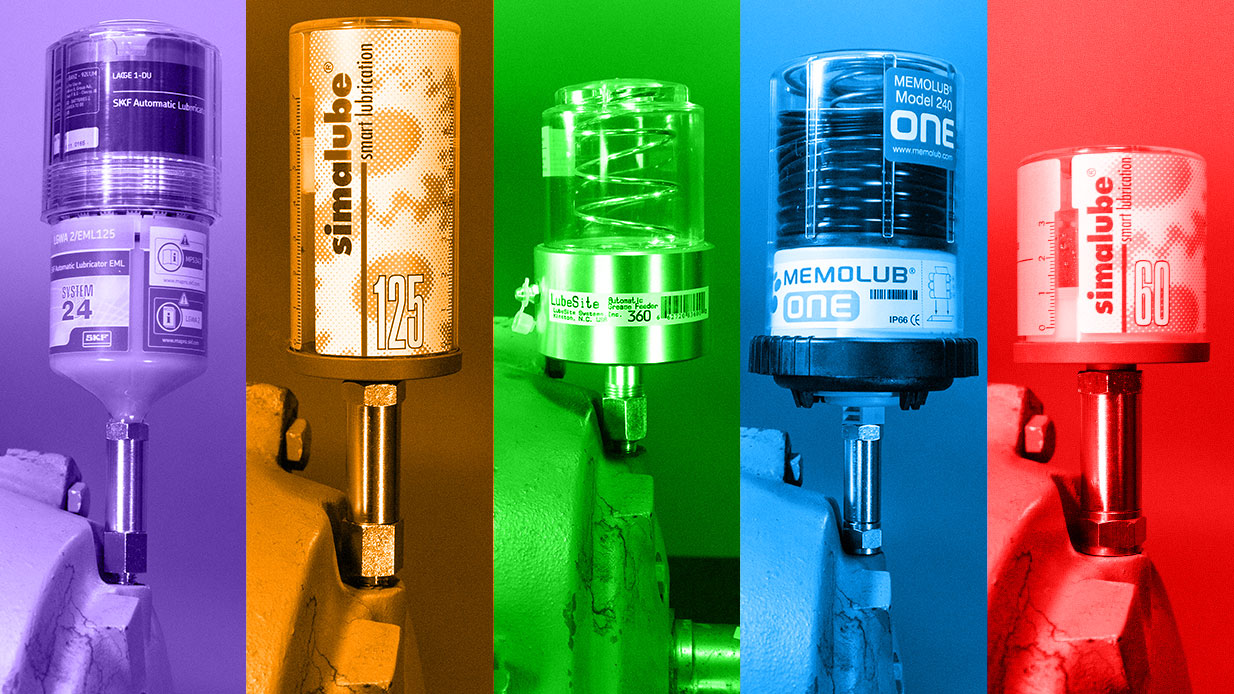
Single-point Lubricator Buyer’s Guide
Around 60 to 80 percent of bearing failures can be traced back to a lubrication issue, whether it’s poor lubricant selection and application, lubricant contamination or lubricant degradation. A single-point lubricator is a device engineered to regularly and automatically deliver a small amount of clean grease or lubricating oil to a specific area. It most often is used to keep bearings lubricated but can also be utilized to lubricate pumps, electric motors, fans, chains and conveyors, among other applications. Manually greasing bearings often results in over- and under-greasing, which eventually leads to premature bearing wear. Single-point lubricators can be configured to dispense the correct lubricant quantity to a single point for a predetermined time period. Single-point lubricators are a popular method of extending the life of bearings and other components as well as preventing extended downtime due to lubrication-related failures. Below, we’ll discuss the various types of single-point lubricators, how they work and how to install them.
Single-point Lubricator Types and How They Work
Single-point lubricator designs have been improved since the traditional grease cup arrived on the scene more than 30 years ago. Modern designs come with features like varying reservoir capacity, multiple pressure and temperature limitations, and multiple discharge rates from weeks, months and even up to a year or more. Let’s take a look at five single-point lubricator designs you should consider.
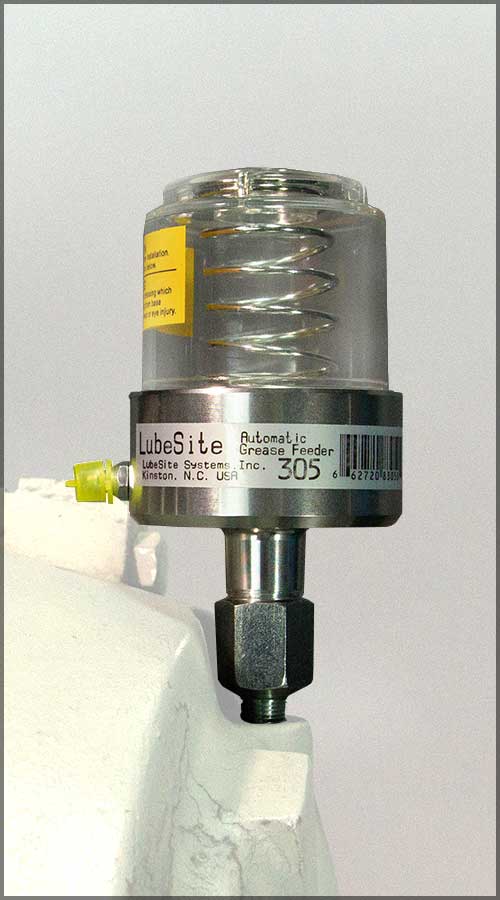
-
Spring-loaded grease cups: Considered an older design, a spring-loaded grease cup is one step above the traditional compression grease cup. Instead of using a screw-down cap or piston, it utilizes a spring-loaded plunger to displace grease. The spring engages the plunger, slowly forcing grease into the bearing. The flow of the grease is influenced by the grease consistency, back pressure and temperature. Grease flow can be adjusted with a piston O-ring, which creates a changing level of friction as it moves down the tapered reservoir wall. This produces a friction counterbalance.
You can achieve various discharge flow rates by inserting different orifice sizes into the lubricator’s discharge nipple. Spring-loaded grease cups are attached by screwing into the threaded grease port. They range in volume size from 2 to 18 ounces (60 to 532 cubic centimeters) and can develop pressures of 2 to 65 pounds per square inch (psi) or 0.14 to 4.48 bar. This type is not recommended for use where there is a wide temperature variation that can affect the consistency of the grease. They should also be avoided in equipment with high vibration due to the thixotropic nature of grease which would increase grease volume delivered.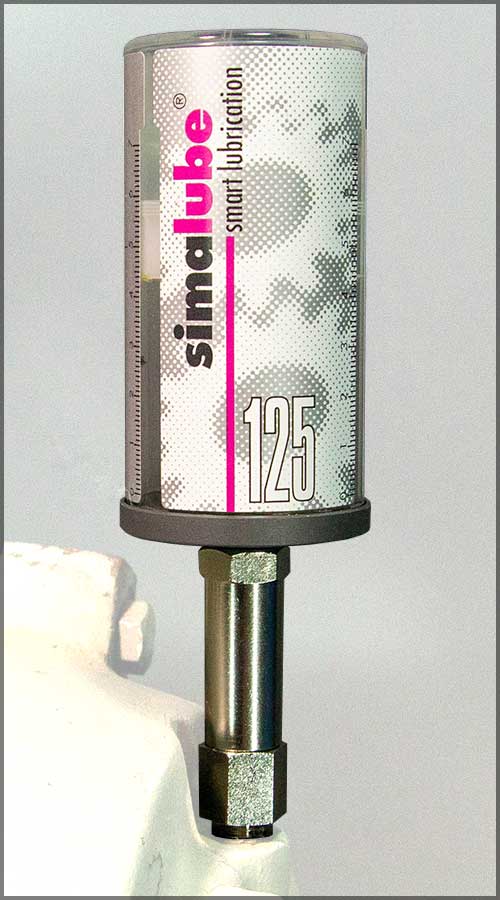
-
Single-point piston-activated lubricator: A single-point piston-activated lubricator (sometimes referred to as an electrochemical lubricator or gas lubricator) consists of a cylinder containing a pressure generator, piston, liquid electrolyte and lubricant chamber. The pressure generator is a rubber bladder filled with an electrolyte solution and a sealed plastic tube that holds a galvanic strip of specially treated metal. Once the piston-activated lubricator is installed, it works by fastening the activating screw into the top, which breaks the plastic tube. This exposes the galvanized metal strip to the electrolyte substance, causing an electromechanical reaction inside the bladder. Gas is then produced.
This gas presses the bladder against the piston, at which point the piston pushes the lubricant into the bearing or component. Once the lubricant has been used, the lubricator is discarded and a new one is installed. The flow of the lubricant discharge can be controlled using electronic controls that adjust gas production and the rate at which grease is displaced. The flow rate for piston-activated lubricators usually is around 0.1 to 0.7 cc per day. Discharge rates are affected by variations in ambient temperature. A rise in temperature increases the discharge rate, and temperature drops decrease the discharge rate.
According to single-point lubricator manufacturers, for electric-motor bearings ranging from 25 to 400 horsepower at an ambient temperature of 77 degrees F (25 degrees C), a unit would discharge approximately 0.166 cc per day and remain in service for 24 months. A higher ambient temperature, such as 113 degrees F (45 degrees C), would change the discharge rate to 0.66 cc per day (an increase by a factor of four) and shorten the lubricator’s service life to nearly six months. A gas leak will impact these lubricators and render them useless. The grease level should be routinely monitored to ensure that it is still pushing grease.
This type of single-point lubricator is available in capacities ranging from around 60 to 500 cc (2 to 16 ounces). Depending on which selector switch you choose, you can control the rate of gas being generated. The dispenser is then adjusted to deliver lubricant at a predetermined rate against atmospheric pressure. Adding back pressure reduces the discharge rate. Some manufacturers produce units capable of achieving discharge pressure of up to 100 psi.
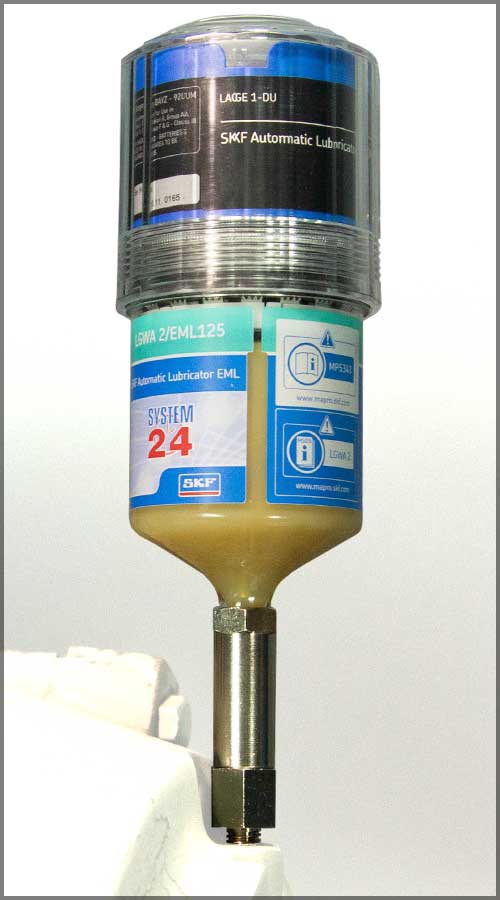
-
Positive-displacement single-point lubricators: One of the more modern designs of an electromechanical single-point lubricator is the positive-displacement unit. As shown in the image to the right, these lubricators come with a reusable battery- or direct-power-operated motor, a refillable or replaceable lubrication canister and a follower plate. When activated the motor turns a threaded rod on which the follower plate rides and pushes grease from the nozzle. This allows the unit to be set for various discharge periods and enables it to be turned off and on with a switch. One of the biggest benefits of these lubricators is being temperature independent, which supports precise discharge times.
This type of single-point lubricator is available in capacities ranging from around 60 cc to well over 600 cc (2 to over 20 ounces). The lubricator can be set to distribute a set amount of grease at a specific interval or to dispense the full volume of grease over a defined period of time. These also commonly have feedback lights that will flash for normal operations and also alert inspectors to abnormal conditions or lubricator failure. They are capable of producing higher pressure and are less susceptible to fluctuations of discharge rates due to changes in ambient temperatures.
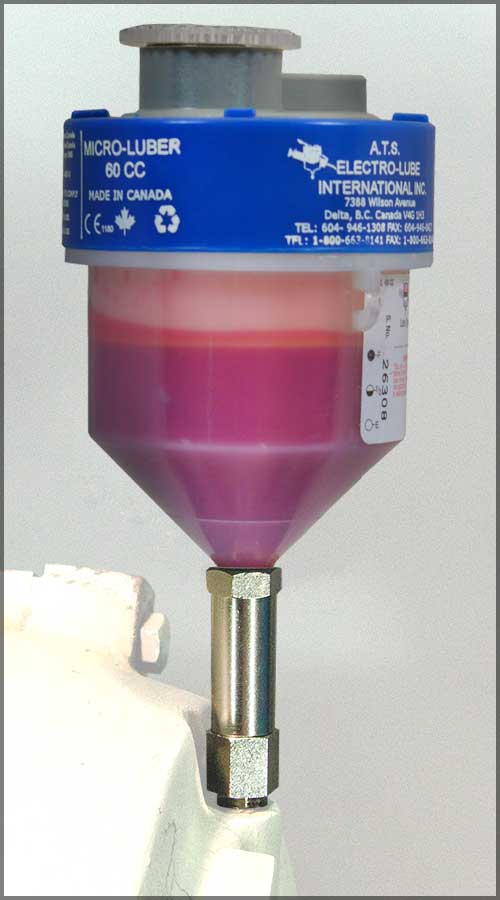
-
Vibration-activated single-point lubricators: More advanced single-point lubricators are available like ATS Electro-Lube’s vibration-activated single-point lubricator. By installing a built-in vibration sensor into an electromechanical lubricator, machinery is lubricated during times of high operational demand only. This means no unnecessary lubrication happens during non-working hours, when the machine is idle, or when it is out of service.
Vibration-activated lubricators still allow for predetermined lubrication schedules (anywhere from 15 days to 24 months), but they only dispense grease or oil when the machine is operational. When the machine is idle, the vibration sensor detects this, automatically switching the unit to pause mode and temporarily stopping the lubrication cycle. These units have three sensitivity levels: low sensitivity for applications with high vibrations, medium sensitivity for most standard machinery, and high sensitivity for low levels of vibration.
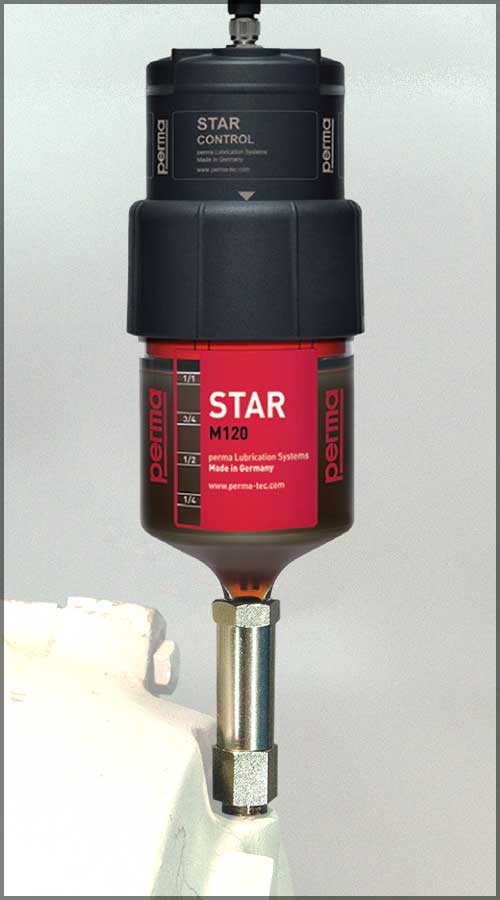
-
Precise-metering single-point lubricators: Applications that require precise lubricant metering will benefit from single-point lubricators like perma’s Star Control lubricator. It consists of an electromechanical drive, a liquid-crystal display (LCD) and lubricant cartridge capacities of 60, 120 or 250 cc (approximately 2-8 ounces). The lubricator is supplied with power via an external power cable and has two operating modes – time and impulse.
When operating in impulse mode, this type of lubricator dispenses a pre-defined quantity as soon as electricity is applied. You can choose the desired amount of lubrication via the LCD. The time mode allows the lubricator to dispense lubrication in predetermined times and operating hours. For example, the Star Control lubricator has a reusable drive, so when all the lubricant within the cartridge is discharged, you simply order a new cartridge and reuse the drive unit.
Precise-metering lubricators are best for electric motors with specific relubrication amount requirements and applications like chains, gear racks, open gears, roller and sliding bearings, and spindles.
When considering which type of single-point lubricator to purchase, it’s important to understand what influences the flow of grease. High ambient temperatures soften grease, making it more fluid and increasing discharge pressure within the lubricators (up to four times). Low line restriction can also increase grease flow.
Conversely, low ambient temperatures stiffen grease, making it less fluid and decreasing discharge pressure. High line restriction like narrow ID lines, gas chamber leakage (gas-type lubricators) and line blockages also contribute to a decrease in grease flow.
Determining which single-point lubricator is right for your environment is key. Now that you know what affects grease flow, you can more easily determine the appropriate lubricator. For example, spring-loaded lubricators are often made of polycarbonate (up to 250 degrees F) or borosilicate (up to 450 degrees F) for protection against high temperatures. Gas-activated lubricators have a low-pressure displacement, which may not be good for environments that decrease grease flow. Positive displacement lubricators control grease flow without resistance and can have discharge pressures nearing 900 psi. They also are not sensitive to temperature or vibration, making them a popular choice.
Electrochemical vs. Electromechanical Single-point Lubricators
There are two main types of modern single-point lubricators: electrochemical and electromechanical. Examples of both have been discussed above, but it’s important to know the difference in general terms so you can understand the mechanics of how each type works
-
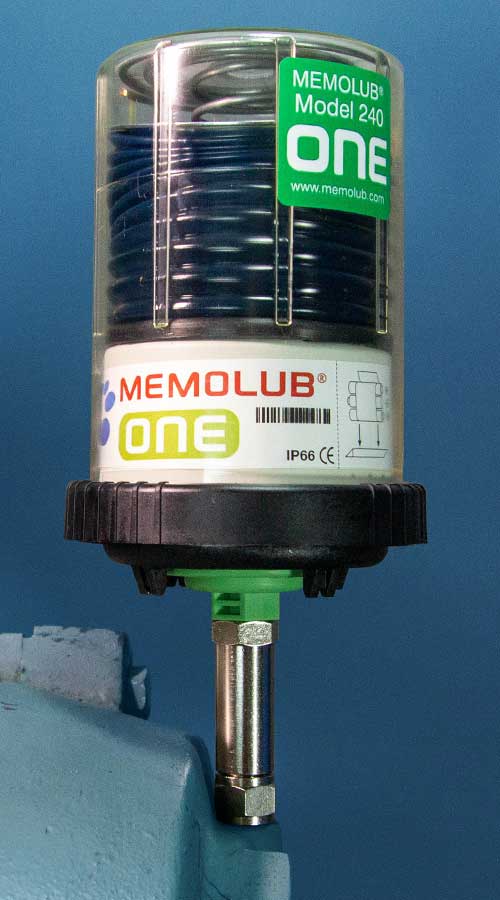 Electrochemical single-point lubricators dispense lubricant at a controlled rate through the use of an internal gas generator. Gas is generated by combining two elements in a sealed chamber. The single-point piston-activated lubricator, which was discussed previously, features a pressure generator that is a rubber bladder filled with an electrolyte solution and a specially treated piece of galvanized metal concealed by a plastic tube. Gas is formed by combining the two elements in the sealed chamber, creating a pressure buildup that presses against the piston and dispenses the lubricant.
Electrochemical single-point lubricators dispense lubricant at a controlled rate through the use of an internal gas generator. Gas is generated by combining two elements in a sealed chamber. The single-point piston-activated lubricator, which was discussed previously, features a pressure generator that is a rubber bladder filled with an electrolyte solution and a specially treated piece of galvanized metal concealed by a plastic tube. Gas is formed by combining the two elements in the sealed chamber, creating a pressure buildup that presses against the piston and dispenses the lubricant.
Due to the use of a chemical reaction to form gas, electrochemical lubricators are sensitive to extreme temperatures; this means the amount of gas formed decreases in low temperatures and increases in high temperatures. Electrochemical single-point lubricators are typically safe to use in hazardous locations depending on the gas that is being produced by the reaction.
-
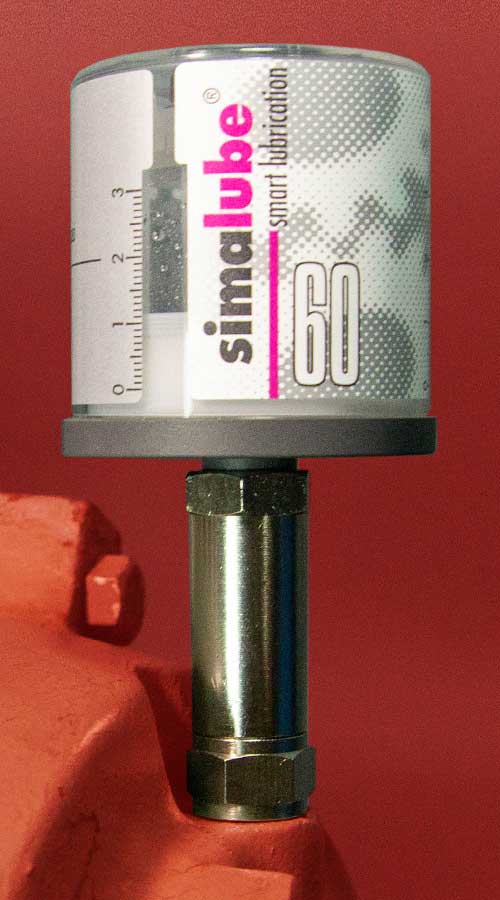 Electromechanical single-point lubricators are battery-powered or powered by an external source. The power sources operate a small motor which activates and advances a piston to dispense lubricant to bearings or another application. These single-point lubricators can dispense grease at higher pressures and aren’t affected by temperature fluctuations. An example of an electromechanical single-point lubricator is the positive-displacement lubricator discussed above.
Electromechanical single-point lubricators are battery-powered or powered by an external source. The power sources operate a small motor which activates and advances a piston to dispense lubricant to bearings or another application. These single-point lubricators can dispense grease at higher pressures and aren’t affected by temperature fluctuations. An example of an electromechanical single-point lubricator is the positive-displacement lubricator discussed above.
Single-point Lubricator Installation
Single-point lubricators are designed to be installed easily into bearing unit adapters. Once you’ve selected the correct bearing unit adapter, the male end of the single-point lubricator threads into the female end of the adapter. Once secure, you can set the desired grease flow according to the instructions for the specific lubricator. Typically, you’ll see discharge periods from one to 24 months.
Electromechanical lubricators usually have a reusable drive motor which allows you to only replace the lubricant cartridge and batteries after each use. Make sure the dual in-line package (DIP) switch setting for volume/cartridge size coincides with the cartridge you’re installing. DIP switch settings generally are located on the cartridge label and in the installation instructions.
There are two ways to mount a single-point lubricator:
- Direct mounting, which was just discussed briefly, is when you mount the lubricator directly into the bearing adapter. This method is recommended for lubrication points with minimal shock loading and vibration as well as for lubrication points that are safe and easily accessible.
-
Remote mounting is necessary when you need to remove protective guards or safety cages to reach a lubrication point, when the lube point is difficult or unsafe to access while the equipment is running, or when the lube point is exposed to high vibration and/or extreme temperatures. Remote mounts come in various designs but are meant to provide an extra 3 to 6 feet of space for easier access to lubrication points. Typical remote mounting kits consist of:
- A standard beam or cage bracket to allow for attachment on a section of beam using a beam clamp, or to square cage mesh with a cage hanger
- A purge connector with manual valve, so you can purge the line, clear grease blockages and add supplemental grease
- An optional angled fitting for each lubrication point
- A push-lock hose connector for each lubrication point
- A heavy-duty hose with push-lock swivel hose ends (ask the distributor about different hose lengths)
Benefits of Single-point Lubricators
Single-point lubricators are designed to give a consistent, measured and continuous supply of fresh grease or lubricating oil. When compared with manual lubrication or other traditional lubrication methods, single-point lubricators offer a few cost-saving and efficiency-gaining advantages, including the following:
- Controlled metered delivery helps mitigate over- and under-greasing. This also increases bearing service, which in turn increases asset reliability.
- Self-contained units mean no moving parts or outside logistics are required once the lubricator is installed and set. They are also easy to install, maintain and troubleshoot.
- Their predictability allows them to be easily worked into a maintenance plan to support proactive maintenance.
- They are designed for flexible installation, so you can place them in confined or unsafe spaces using direct or remote installation.
- A reduction in maintenance costs is often seen thanks to their automation, which makes them nearly maintenance-free, reduces maintenance hours and lowers labor costs. Not only can you reduce maintenance hours, but you can also mitigate human error.
- Can be installed in areas that require greasing that aren’t safe to get to during normal equipment operation.
Single-point Lubricator Prices
The prices of single-point lubricators can run the gamut and will depend on multiple factors. Keep in mind that mounting kits and other accessories are sold separately. Among the factors that will affect the price include:
- Lubricator/drive type: single- or multi-point, single- or multi-use, spring-loaded grease cup, electrochemical, electromechanical, etc.
- Included components: cartridge, refill set, pump, etc.
- Power supply: DC, VDC, lithium or DC battery, gas, etc.
- Reservoir capacity: usually found in ounces, milliliters or cubic centimeters
- Lubricant type: food-grade, multi-use, extreme-pressure, high-load, high-temperature, etc.
Prices may be as low as $32 to $64 for a single-use grease cup and as high as $800 for electromechanical lubricators filled with specialty grease (synthetic, anti-wear, organo-clay, extreme temperature, etc.). While these prices represent the low and high end of the spectrum, the majority of lubricators hover around the $100 to $300 price range.


.jpeg)

